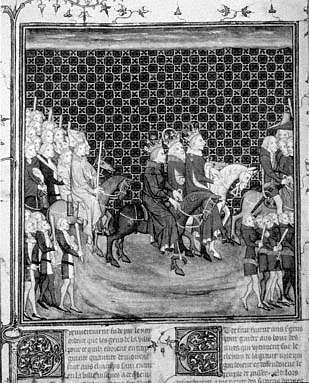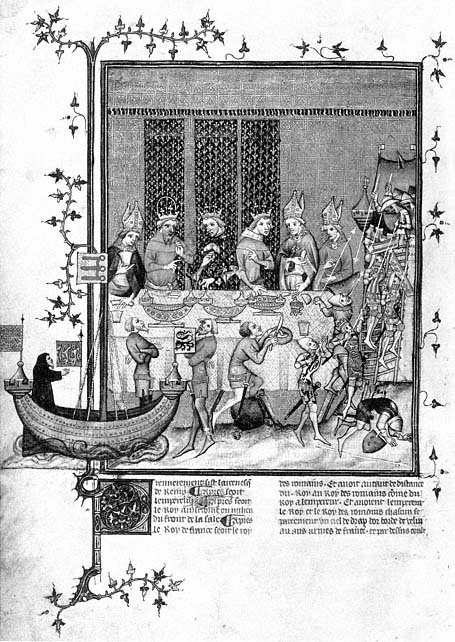The Visit of the Holy Roman Emperor
The description of the emperor's visit to Paris in 1378 is the most densely illuminated segment of text in Charles V's Grandes Chroniques .[37] In this subcycle, 18 miniatures decorate 13 folios. They portray the visit from the arrival of the emperor's letter announcing his impending trip (fol. 464) to letters received at court after his departure (fol. 480). The action between concentrates on ceremony. In this portion of the chronicle, text and image together emphasize the preeminence of the French over the emperor. For example, two miniatures illustrate the chapter in which the emperor stayed in the imperial city of Cambrai at the insistence of Charles's messengers, so that he could play his customary imperial role in the religious ceremony celebrated at Christmas without interfering with Charles's kingly role. The first miniature shows the pomp of his entry into Cambrai and the second his part in the celebration of the Christmas mass. The Grandes Chroniques's text makes the issue clear: "Because the emperor customarily said the seventh lesson at matins, dressed in his imperial clothes and insignia, he was advised by the king's men that he could not and would not be permitted to do this in the king's realm."[38] The second miniature shows the imperial ceremony in such detail that the first few words of the seventh lesson, which the emperor declaimed, are inscribed on the book placed on the podium.[39]
Other miniatures in this section of text are notable for their scale as well as for their close relation to their texts. For instance, a sequence of three miniatures (fols. 469, 470, 470v) illustrates the emperor's approach to Paris, the meeting of emperor and king, and their entry into Paris; the miniatures increase in size from

Figure 90
Entry of Charles V, Charles IV, and Wenceslaus into Paris.
Grandes Chroniques de France .Bibliothèque Nationale,
Ms. fr. 2813, fol. 470v.
Photograph: Bibliothèque Nationale, Paris.
one and one-half columns, to two columns, to three-quarters of a page.[40] As in the picture of the emperor in Cambrai, these images stress French ascendancy. The Grandes Chroniques records that Charles V, in order to emphasize the ban on imperial signs on French soil, purposefully chose dark horses, rather than the white ones traditionally given to emperors, for Charles IV and his son Wenceslaus when they met the French king outside Paris. In the illustration of the entry (Fig. 90) the emperor and his son ride dark horses while Charles V sits astride a white horse and wears a crown in place of the hat required by the text.[41] It is likely that this detail of costume was introduced to emphasize Charles's equality with the Holy Roman Emperor.
The largest and most problematic miniature in the subcycle of the imperial visit is that of the Great Feast (Fig. 91). This picture, along with the Order of the Star miniature discussed in Chapter 6, is one of only two illustrations in Charles V's manuscript referred to directly in its accompanying text. As in the image of the Order of the Star, the passage preceding the miniature of the Great Feast refers explicitly to the picture that follows: "And thus they went without a great hurry . . . to the large dais with the marble table and the grouping of figures and

Figure 91
Great Feast. Grandes Chroniques de France . Bibliothèque Nationale, Ms. fr. 2813, fol.
473v. Photograph: Bibliothèque Nationale, Paris.
their positions were as described below and as is figured in the miniature hereafter portrayed."[42] With the exception of a few simplifications required to depict a large crowd in a small area, the illustration conforms to the description of the diners that begins just below the picture. It records the positions of Emperor Charles IV, Charles V, Wenceslaus, and the bishops who dined with them. The representation of the play, which fills the right side and the foreground of the miniature, however, contains elements not specified by the text. The Grandes Chroniques states that the play was about the history of Godfrey of Bouillon and the conquest of Jerusalem. It speaks of Peter the Hermit, of Godfrey, and of the "noble knights who were at the conquest of Jerusalem," but it does not identify these knights. The picture, however, includes four sets of arms, on the boat and on the individual knights who storm Jerusalem: Godfrey of Bouillon's arms are at the stern of the ship at the far left, England's are on a spear, Auvergne's on the mast, and Flanders's at the bow.
Contemporary descriptions of this crusade demonstrate that the storming of Jerusalem portrayed in the miniature includes at least two anachronisms. Godfrey was not king during the assault on Jerusalem; he was crowned later.[43] Further, the counts of Flanders and Auvergne participated in the assault, but the king of England was not there. Instead, his brother, Robert of Normandy, took part.[44] Artistic error alone cannot explain the latter discrepancy; besides adding an extra lion to the arms of Normandy, thus transforming Normandy's two lions into England's three, the artist also placed a crown on the head of the figure who bears these arms and stands at the foot of the ladder outside Jerusalem's walls. Clearly the artist intended to portray the king of England.[45]
The description that the Grandes Chroniques gives for selecting this play provides a possible explanation for these changes. According to the chronicle, the king chose to have the story of Godfrey of Bouillon performed because he believed that there was no better example to put before the noblest men in Christendom who "were best able, ought, and should undertake such a feat in the service of God."[46] Taken at face value, this statement suggests that the play was intended to kindle crusading fervor in those who watched it. This is difficult to prove, since there is little evidence that Charles V was ever seriously interested in a crusade.[47]
A comparison of this image with that of the Order of the Star suggests a different explanation for its prominence in the manuscript. Not only are the miniatures of the Order of the Star (Fig. 76) and the Great Feast (Fig. 91) thematically related, they are also large in scale, occupying three-quarters of a manuscript page; they incorporate elements not described in the chronicle; and they are the only two miniatures in the manuscript to be referred to explicitly by their texts. It is possible that the picture of the Great Feast, painted in the third stage of execution, was designed to refer back to the Order of the Star, painted in the second stage, just as other miniatures and texts from the third stage refer back to the second.
As we have seen, the miniature of the Order of the Star celebrates John the Good and French chivalry and, by contrast, denigrates the English whose treachery is the actual subject of the text it illustrates.[48] Given the relationship between these miniatures, it is reasonable to suggest that the Great Feast may have had a similar function within the framework of the imperial visit. The portrayal of the English king in the capture of Jerusalem when it was known that he did not participate
suggests that its function was to convey a message about England similar to the message conveyed in Charles V's speech.[49]
One of Charles's goals for the imperial visit was to persuade the Holy Roman Emperor to condemn England's actions in the Hundred Years' War. The plea he delivered before the emperor the night after the state dinner at which the play was performed (and recorded in the text of the Grandes Chroniques two chapters after the description of the dinner), presented a litany of dastardly English deeds that contrasted markedly with the portrayal of the English monarch in the play.[50] Charles described an English king who broke treaties and ordered the murder of emissaries, but the crusading play portrays a heroic English king assisting in a triumph over the infidel. Whether this idealized king is Richard the Lionheart, a hero of the Third Crusade, or simply an invention of the designer of the play or program of decoration is unimportant. His heroic stature emphasizes the evil of Edward III as Charles described him. This contrast between exemplary and reprehensible behavior in picture and text is very similar to that established by the Order of the Star miniature and text.
The portrayal of the arms of Flanders and Auvergne in the Great Feast miniature may constitute an additional contemporary reference. Of all the nobles who were with Godfrey when he stormed the walls of Jerusalem only the counts of Flanders and Auvergne accompany him in this miniature. They may have been selected because the counties of Flanders and Auvergne belonged to Philip, duke of Burgundy, and John, duke of Berry, two of Charles's brothers, who played important roles in the protocol of the emperor's state visit.[51] The depiction of their predecessors as counts in the play may have been a compliment to them.
By analyzing the three stages in the production of Charles V's Grandes Chroniques we can thus chart the changing concerns of one French king. As first conceived, the book ended with the life of Philip of Valois and was illustrated with generalized pictures whose images reflect the young king's particular concerns: the history of his ducal predecessors in Normandy; his holy ancestors, Charlemagne and Saint Louis; the concept of legitimacy; and the idea of empire.
During the second stage of execution the text was expanded to include the reigns of John the Good and Charles V to the events of 1375. One series of pictures focuses on Charles's difficulties with Étienne Marcel and the Estates General and with Charles of Navarre, carefully incorporating detail drawn from the chronicle into illustrations that relate exclusively to their own texts. A second series of miniatures depicts ceremonies. These pictures not only illustrate events described in the text but also work together to develop dynastic themes—the promotion of John the Good as a model of good kingship and the assurance of Valois continuity in the person of the dauphin Charles.
Perhaps as a response to the worsening political situation in France, the use of miniatures of ceremony was more common during the third stage of execution. All but two of these illustrations assert French ascendancy over the empire. Finally, Valois legitimacy is emphasized by four illustrated texts and one full-page miniature executed during the third stage for substitution into the first portion of the manuscript.
Charles V's Grandes Chroniques is radically different from those versions that went before. Unlike its predecessors, it includes a continuation written at court that brings it up to the present and describes the acts of its patron. Perhaps
because Charles V was a politically astute monarch as well as a noted bibliophile, pictures and text in his Grandes Chroniques were altered almost every time the political situation changed. His chronicle therefore records events of his reign and reflects his changing political thought and contemporary French propaganda during a stressful time in French history. During Charles V's lifetime the book was probably available only to the king and a select group of courtiers. Nevertheless, this Grandes Chroniques addresses the same issues as the more public celebrations of monarchial authority expressed in speeches, ordinances, or ceremonies. This book, which survives while more ephemeral public art has been destroyed, is thus an important historical document that, as we shall see, had a profound influence on subsequent copies of the text.